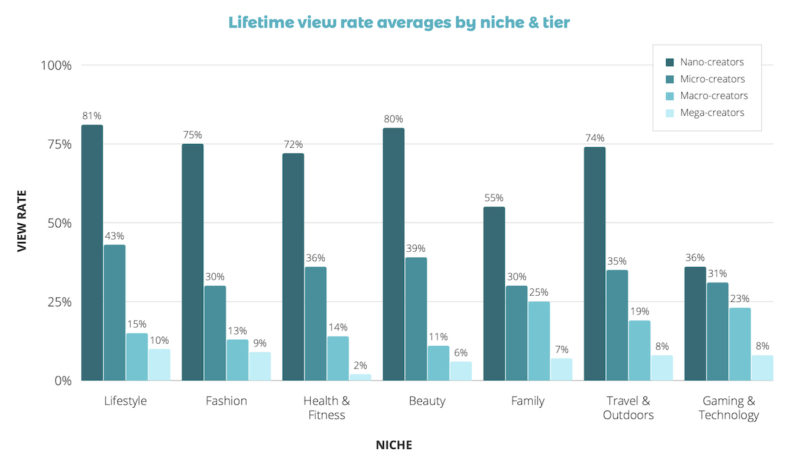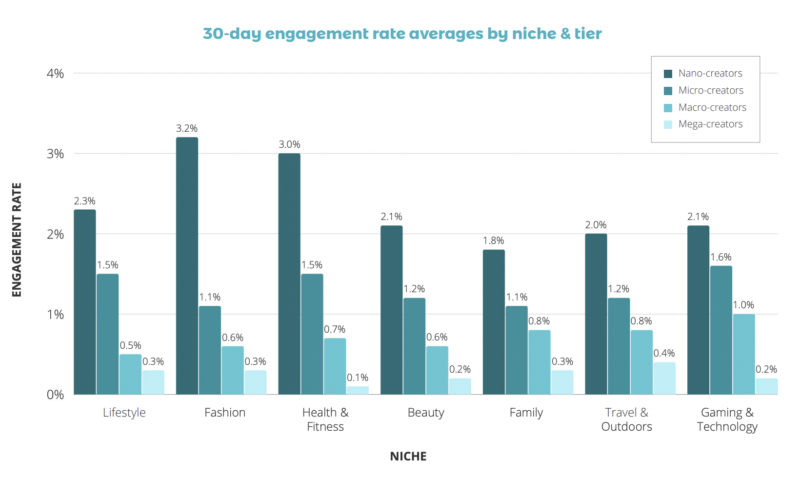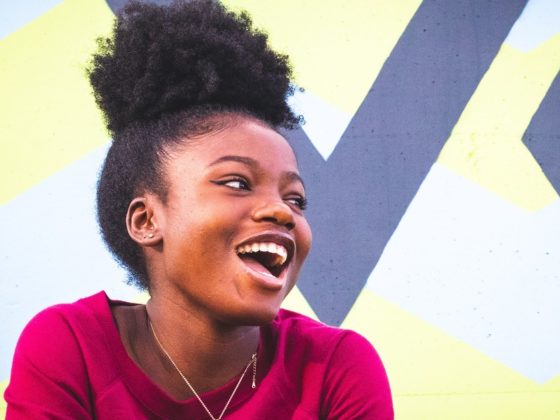Collaborations on YouTube can be a great way to establish yourself as a creator and build credibility. More than 1 billion hours of video are watched every day on the platform, making it a channel filled with opportunities!
But it can be difficult to know what results brands expect from a collaboration. How do they decide which creators to work with? What metrics do brands focus on? And how do they know a collaboration was successful?
You’ll find the answers to these questions and more in this article! It breaks down our latest YouTube Creator Performance Benchmarks Report 2022. The report is an in-depth analysis of thousands of videos from creators on the inzpire.me platform.
Understanding benchmarks is valuable because it’ll help you learn how you perform as a creator. You’ll be able to land more collaborations by understanding what results brands are after and what top-performing creators achieve.
Below, you’ll learn what benchmarks are and how to use them. You’ll also get some tips for improving the performance of your YouTube content.
Table of Contents
What’re YouTube benchmarks?
Put simply, YouTube benchmarks are the performance results your content should be achieving based on your subscriber size and niche, like Lifestyle or Fashion.
These give an accurate overview of how you’re reaching and engaging your audience with your content.
For YouTube, there are 2 sets of benchmarks, lifetime and 30-day. Here’s what they are and how they can be used.
Lifetime benchmarks
Lifetime benchmarks give you a more detailed picture of how your content performs in its lifetime.
Brands use these to help them find top-performing creators for collaborations. They do this by comparing your average view rates and engagement rates to the lifetime benchmarks.
This means you should aim for your content to perform at or above the average lifetime benchmarks as it’ll make collaboration requests more likely.
You can use the benchmarks below to see how you’re performing:


But how do you actually use them in practice?
Let’s say you’re a Fashion macro-creator with 200,000 subscribers, and your most recent videos get 65,000 views on average. Your average view rate can be worked out using this formula:

This gives you an average view rate of 32.5%. Your view rate is higher than the benchmark rate of 30% for Fashion creators. So you’d be considered a top-performer by brands!
Working out your average engagement rate is a similar process:

Using the same example, you should have a 1.8% engagement rate. This means getting 3,600 engagements on your videos, on average.
If you find your videos aren’t performing as well as they should, don’t worry! You’ll find a couple of things you can do to improve your performance further down the article.
30-day benchmarks
If you’ve already received collaboration requests on YouTube, that’s great! Now you’ll want to make sure you deliver great content and results to the brand.
30-day benchmarks are the performance results that your videos should be achieving 30 days after you publish a video on YouTube. This is used by brands to measure how creators perform, and determine whether they should book them again for another collaboration.
For you, these can be used to work out if you’re delivering the results brands expect for your size and niche.
You can use the graphs below to help you with this:


Let’s look at how these benchmarks can be used in practice.
Say you’re a Lifestyle macro-creator with 200,000 subscribers. Your sponsored content got 31,000 views in the first 30 days.
To work out your 30-day view rate, you can use the formula below:

This means the view rate you achieved 30 days after publishing is 15.5%. If you take a look at the 30-day benchmark graph above for the Lifestyle niche, macro-creators have an average view rate of 13%.
Your video performed above the benchmark here, which increases your chances of getting booked for a collaboration again!
Tips for improving your content performance
So, now you know what benchmarks are for and how you can use them. But what if your content is falling short of the benchmarks?
Read on to learn our tips on getting collaboration requests and meeting brand expectations.
Tips for getting collaboration requests
Share quality content regularly. The quality of your video content directly affects how well they rank and how many views they get.
Quality matters to your viewers, and it impacts the performance of your channel. If your video has terrible resolution or sound quality, your viewers won’t be watching your videos for long!
When you make your video, ask yourself: Are there any distractions in the background? Is the video too dark or bright? How’s the resolution? Is the sound clear? Are there any unnecessary noises?
Your finished videos should be professional, clear, and well-lit. They should also have high-resolution and great sound quality.
Promote your YouTube channel on other social media channels. Once you publish your video content, you should cross-promote it on your other social media channels and send it out in your newsletters. You can also add it to your email signature.
It’s an effective method to get people you communicate with to view your videos.
There are many creative ways you can do this! Try embedding your video in a blog post, adding it to a tweet, putting the video link in your bio, or creating an Instagram Story about it.
If you’re struggling to grow your channel, learn more about how to get noticed on YouTube.
Tips for delivering the best collaboration results
Decide if the brand is a good fit. It’s important to consider whether the brand is relevant to your audience.
One of the reasons your audience follows you is because they’re interested in your niche. But promoting a product or service that isn’t relevant can have a negative impact on your view and engagement rate.
Your audience will see the collaboration is a mismatch and choose not to watch or engage with your video. So make sure the brand is a good fit to achieve the best collaboration results!
As an added tip, take a look at the brand’s social media channels and company website to make sure you share similar values and aesthetic. It’ll only make the collaboration more authentic!
Create engaging, personal content. As a creator, you’re a great storyteller! And when a brand works with you, they want you to promote them in a personal and authentic way. Aim to share a brand’s message in a way that resonates with your viewers.
In our experience, the best collaborations are the ones that are personal. You can do this by giving real life examples of how you use a product or explaining how you see it fitting into your life.
Read our full list of tips to succeed in brand collaborations on YouTube.
Final thoughts
You now have a better idea of what benchmarks are and how you can use them. Having an understanding of these benchmarks and what brands expect will only increase your chances of getting more collaborations.
Follow these tips to improve your video performance, and we’re sure you’ll grow your creator career in no time!










